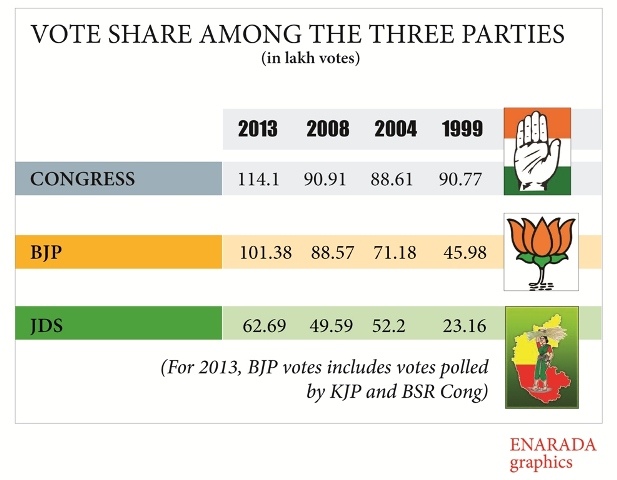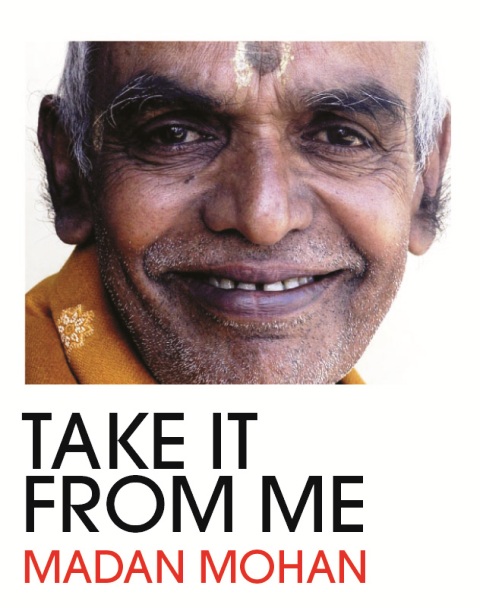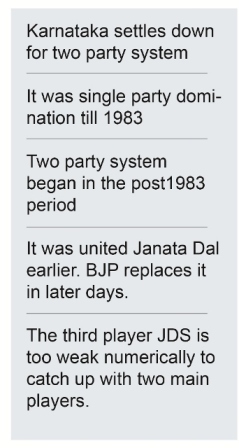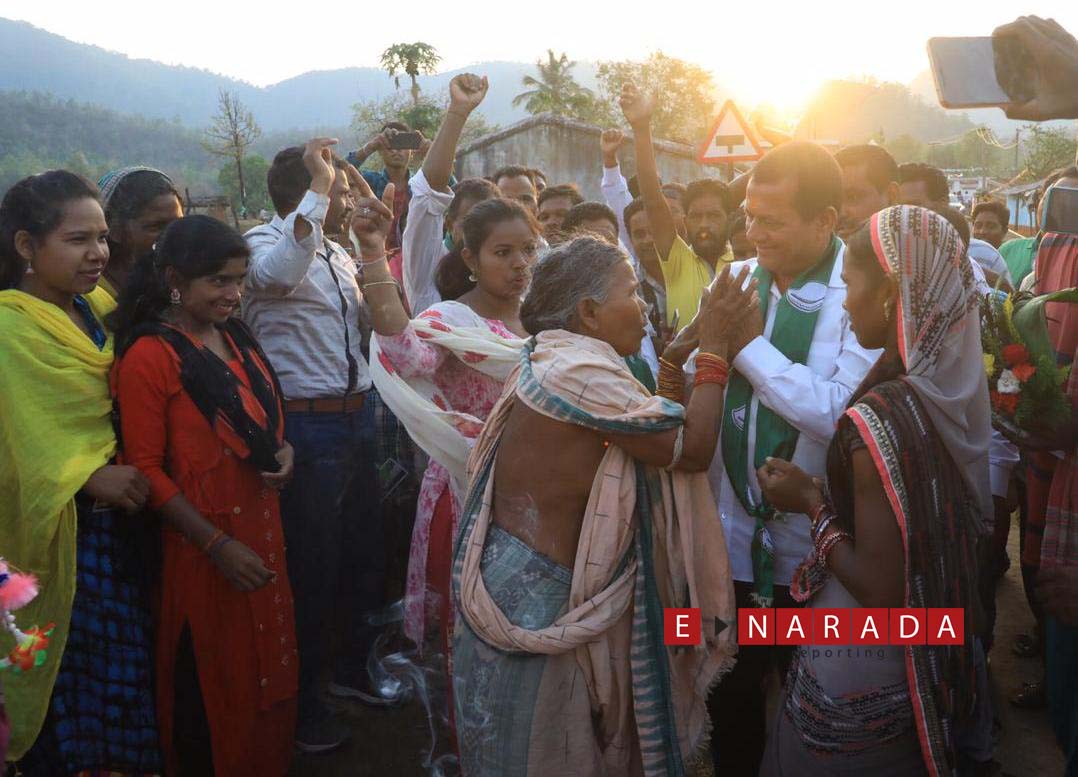ENARADA, Hubli
By Mathihalli Madan Mohan
The concept of third front, about which much is being talked at the national level, has absolutely no relevance in the context of Karnataka. The concept is in doldrums at the national level and is an impossible in Karnataka.
Starting with a single party hegemony of Congress, Karnataka has settled down to a two party system for the past nearly two and half decades. And the JDS, the third party in the Frey lags too far behind and is in hardly any position to challenge the other two on its own or an association with other parties, with hardly any base worth the name. The choice for the electorate be it the assembly or the parliament election is simple – pro or anti Congress. Initially Janata Dal filled the anti-Congress slot and on its fall, the slot has been taken over by the BJP.
In the past two assembly elections including the 2013 poll, the Congress and BJP, between themselves raked 70% of the polled votes, almost on near equal basis and the rest has been shared between JDS, styling itself as charting the third path between the Congress and BJP. It has a poorer electoral base (18-20%) than the two main line parties, and is not in a position to take on them either singly or in association with others including the national parties like CPIM, CPI, BSP to name few among the plethora of parties tattooing the political scene, with a notional existence.
 What contributed to the birth of an alternative to Congress in Karnataka, has been the gradual rise in the anti-Congress votes in the state. The Congress ruled the roost as the unquestioned leader for the first 27 years till 1983. Its ham-handed handling of the episode of Veerendra Patil who had become the Chief Minister after wresting power from the JD resulted in the Congress grip was among factors, which contributed to the Congress losing grip over Northern Karnataka, which had been a long time bastion of the party. The Northern Karnataka did not forgive Rajiv Gandhi and Congress for the manner in which Patil was eased out of office rather unceremoniously. The Congress has never been able to regain the primacy in the region.
What contributed to the birth of an alternative to Congress in Karnataka, has been the gradual rise in the anti-Congress votes in the state. The Congress ruled the roost as the unquestioned leader for the first 27 years till 1983. Its ham-handed handling of the episode of Veerendra Patil who had become the Chief Minister after wresting power from the JD resulted in the Congress grip was among factors, which contributed to the Congress losing grip over Northern Karnataka, which had been a long time bastion of the party. The Northern Karnataka did not forgive Rajiv Gandhi and Congress for the manner in which Patil was eased out of office rather unceremoniously. The Congress has never been able to regain the primacy in the region.
The undivided Janata Dal, as a credible alternative to Congress materialised thanks move on the part of late Ramakrishna Hegde in consolidating the anti-Congress votes way back in 1983. An understanding between the Janata Party and other opposition parties cooked the goose of Congress for the first time in 1983 and Janata Party later renamed as Janata Dal did so in two assembly elections in 1985 and 1994. It has been the Northern Karnataka which played a sheet anchor role in the success of the undivided Janata Dal and the BJP.
The 1996 was a year glory and fall of the Janata Dal from the political pinnacle. That was the year, when Janata Dal won 16 of the 28 loksabha seats and on this strength, due to quirk of circumstances at the national political scene, Janata Dal’s Chief Minister Mr. Devegowda was catapulted as the Prime Minister of the United Front government at the Centre.
The elevation of Mr. Devegowda was the beginning of the end of Janata Dal experiment in Karnataka. A vindictive action on the part of the new Prime Minister Mr. Devegowda in drumming out Ramakrishna Hegde brought about the split in the party between the JDU owing allegiance to Hegde and JDS led by Mr. Devegowda. As a consequence Congress came back to power in 1999 while JDU became practically nonexistent politically, and the JDS did not evoke the trust of the electorate as the true inheritor of Hedge legacy.
The decline in the undivided Janata Dal however did not restore in the political hegemony of Congress. But paved way for the birth another anti Congress outfit, namely BJP, which was dormant as long as the undivided Janata Dal existed. The party was nowhere in the reckoning. Its tally of assembly seats had plummeted from 18 in 1983 to 2 in 1989 as the undivided Janata Dal strode on the political scene. The political vacuum created by demise of undivided Janata Dal spurred the growth of the BJP and it never let the opportunity to slip away. It emerged as the single largest party in 2004 and partnered the JDS in the form of the second coalition government with JDS and came to power on its own in 2008. The split in the party, and faction feuds cost the party, the power in 2013. But the combined vote base of the main party and the two splinter units, namely Karnataka Janata Paksha (KJP) of Yeddyurappa and Badavara Sramikara Raithara (BSR) Congress of Sriramulu both of have since returned to the party fold has reinforced the view that it remains as second largest party in Karnataka, and is within a striking distance with main rival as for the electoral base is concerned.
And the Janata Dal (S) has a remained merely as a rump of once powerful and popular undivided Janata Dal. It was not able to capture the political élan of the days of Ramakrishna Hegde. It has singularly failed to emerge as the true inheritor of the past legacy.
The Northern Karnataka, which had proved to be sheet anchor of undivided Janata Dal, has shut its door firmly to JDS. This is mainly because of the two main factors. Firstly the manner in which Gowda hounded out Ramakrishna Hegde has left a deep scar in the psyche of the people of region especially in the Bombay Karnataka area. Secondly Gowda is being perceived mainly as anti Lingayat and anti Northern Karnataka, because of plethora of sins of omission and commission. The northern region simply does not trust him and thereby put an end to the dreams of Gowda to regain political power. His party is forced to remain in the third slot, with a limited influence in some districts of Old Mysore region, thus limiting its influence and reach It can only play the role of third fiddle in Karnataka, and maneuver for power in the event of hung assembly as it had happened in 2004-2008 period and not otherwise.
The JDS started poorly with a measly 23 lakhs votes when it made its electoral debut in 1999, remaining in the 4th position below JDU. But with JDU out of the way from 2004, JDS polled 52 lakhs, which went down to 49.59 lakhs in 2008, but recovered to move up to 62 lakhs in the just concluded 2013 assembly election. This was when the polled votes moved up from 251 lakhs to 312 lakhs. The Congress had an average vote share of 91 lakhs and moved up to 114 lakhs in the 2013 election. The BJP in the three elections had improved from 71 lakhs to 88 lakhs to end up with a combined strength of 102 lakhs in 2013.
Another interesting aspect has been that a section of the voters who would have preferred the JDS in assembly polls does not do so in the parliament polls. A section of them turns to the national parties in general, the BJP in particular during the loksabha polls.
Under circumstances, as said earlier, the prospects of JDS challenging others either on its own or with other players, all of whom are minor players are impossibility for all practical purposes.
(Posted on March 8 , 2014 @ 3 pm)
(Author is a Senior Journalist and Columnist. He can be contacted on Mobile: +91 94480 74872 / Email: madan.mm@gmail.com)
The views expressed on the website are those of the Columnists/ Authors/Journalists / Correspondents and do not necessarily reflect the views of ENARADA.











